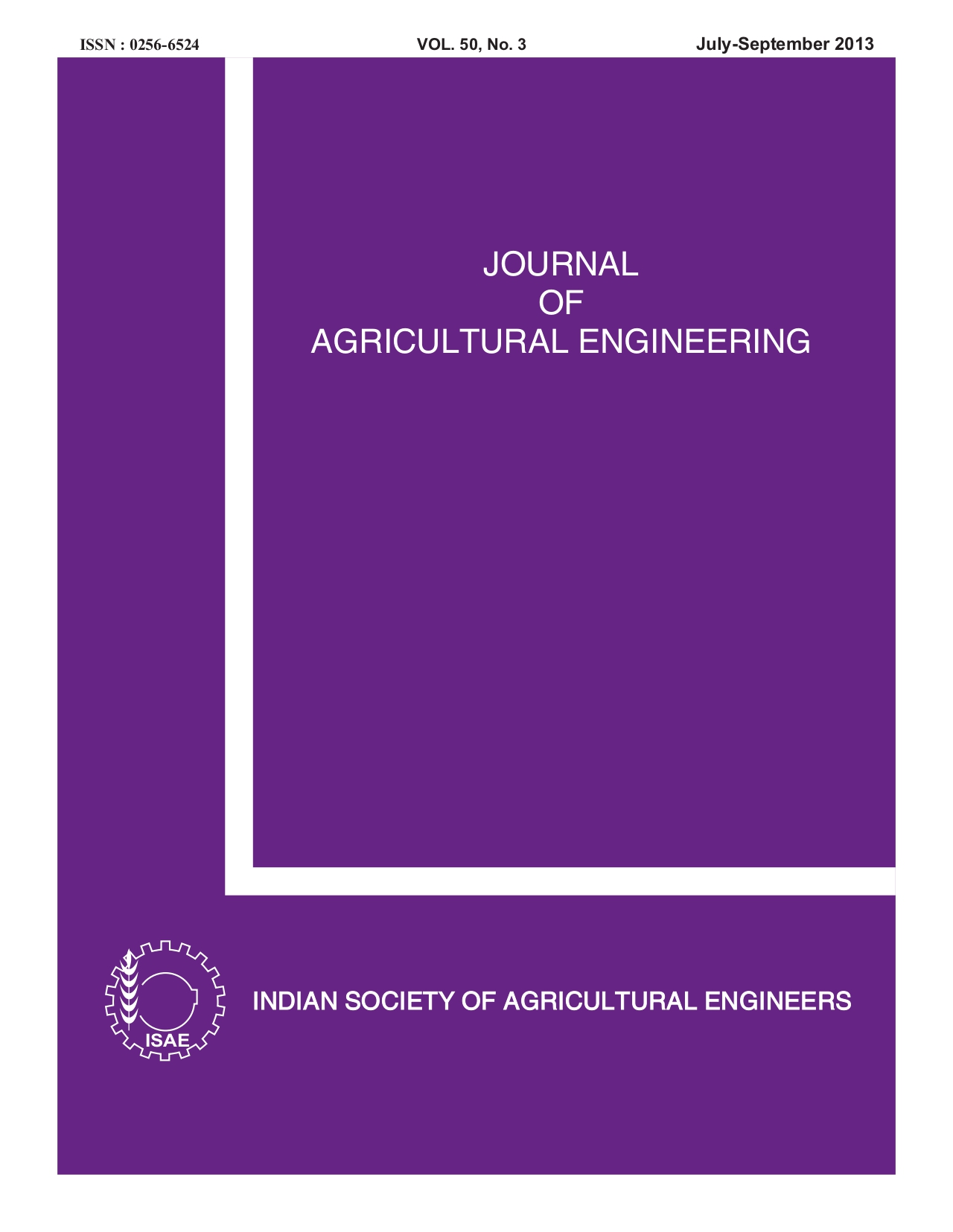Hydrological Impact of Bioengineering Conservation Measures on Cashew Plantations in Lateritic Soils of Konkan Region
DOI:
https://doi.org/10.52151/jae2013503.1524Keywords:
Bioengineering measures, cashew, continuous contour trenches, lateritic soils, nutrient loss, runoff, soil loss, staggered contour trenchesAbstract
Hydrological impact of various bioengineering conservation measures viz. Half-moon Terraces + Vetiveria zizanioides + Stylosanthes scabra, continuous contour trench + Vetiveria zizanioides + Stylosanthes scabra, graded trench + Vetiveria zizanioides + Stylosanthes scabra, staggered contour trench + Vetiveria zizanioides + Stylosanthes scabra and semi-elliptical trench + Vetiveria zizanioides + Stylosanthes scabra on three-year old cashew plantations were assessed on lateritic soil of Konkan region in Goa State. The study revealed that the bioengineering measures tried in cashew plantation on hill slope had a significant effect in reducing annual runoff, soil loss and nutrients losses. Bioengineering measures reduced runoff by 5 to 12.8% as compared to no-conservation measure. Out of all the bioengineering measures, continuous contour trenches with Stylosanthes scabra and Vetiveria zizanioides, followed by staggered contour trenches with Stylosanthes scabra and Vetiveria zizanioides reduced runoff by 12.8 and 10.3%, respectively. Continuous contour trenches with Stylosanthes scabram Vetiveria zizanioides and staggered contour trenches with Stylosanthes scabra and Vetiveria zizanioides reduced soil loss by 11 and 8 t.ha–1.yr-1 in cashew field, respectively. Minimum major nutrients losses were monitored in the treatment of continuous contour trenches with Stylosanthes scabra and Vetiveria zizanioides, followed by staggered contour trenches with Stylosanthes scabra and Vetiveria zizanioides, while the maximum nutrient losses was recorded in control plot. The highest soil and water conservation efficiency was observed in continuous contour trenches with Stylosanthes scabra and Vetiveria zizanioides (47.4%), followed by staggered contour trenches with Stylosanthes scabra and Vetiveria zizanioides (35.9%) and it was lowest (18.3%) in half-moon terraces with Stylosanthes scabra and Vetiveria zizanioides. It was concluded that the continuous contour trenches with Stylosanthes scabra and Vetiveria zizanioides as vegetative barrier was most efficient as compared to all other treatments for runoff, soil loss and nutrient loss reduction. Staggered contour trenches with Stylosanthes scabra and Vetiveria zizanioides was the alternative measure for reducing runoff and soil and nutrient losses in cashew land use.References
Badhe V T; Magar S S. 2004. Influence of different conservation measures on runoff, soil and nutrient loss under cashew nut in lateritic soils of south Konkan region. Indian J. Soil Cons., 32 (2),143-147.
Cox C A; Sarangi A; Madramootoo C A. 2006. Effect of land management on runoff and soil losses from two small watersheds in St Lucia. Land Degrad. Dev., 17(1), 55-72.
Dilshad M; Motha J A; Peel L J. 1996. Surface runoff, soil and nutrient losses from farming systems in the Australian semi-arid tropics. Aust. J. Exp. Agric., 36 (8), 1003–1012.
Kale S R; Ramteke J R; Kadrekar S. 1988. Effect of land development on runoff retardance under lateritic soil. Indian J. Soil Cons., 16 (1), 55-51.
Khola O P S; Sastry G. 2005. Conservation efficiency of mechanical measures and productivity of maize -wheat cropping sequence under different land slopes in foothillsof western Himalaya. Indian J. Soil Cons., 33 (3), 221-224.
Manivannan S. 2004. Slope area characterization of Goa. Indian J. Soil Cons., 32 (3), 245-246.
Manivannan S. 2010. Impact of bioengineering measures on soil moisture retention and major nutrients under cashew land use in lateritic soils of Goa. J. Soil Water Cons., 9(1),9-12.
Manivannan S; Rajendran V; Ranghaswami M V. 2010a. Effect of in-situ moisture conservation measures on fruit and nut quality of cashew (Anacardiumoccidentale) in lateritic soils of Goa. Indian J. Soil Cons., 38(2), 116-120.
Mishra P J; Sahu D. 2001. Comparative performance of vegetative barriers in north eastern ghat zone of Orissa. Indian J. Soil Cons., 29 (1), 50-52.
Parson DA. 1954. Coshocton - type runoff samplers. USDA, ARS, 41-42.
Prasad S N; Singh R K; Shakir Ali; Parandiyal A K.2005. Comparative performance of grass barriers on erosion and crop yields in medium black soils of Kota. Indian J. Soil Cons., 33(1), 58-61.
Rai R N; Singh A. 1986. Effect of hill slopes on runoff, soil loss and nutrient loss and rice yield. Indian J. Soil Cons., 14 (2), 1-6.
Renard K G; Foster G R; Weesies G A; McCool D K; Yoder D C. 1997. Predicting soil erosion by water: a guide to conservation planning with the Revised Universal Soil Loss Equation (RUSLE). USDA-ARS, Agricultural Handbook, No. 703.
Subudhi C R; Pradhan P C; Senapati P C. 1998. Effect of vegetative barrier on soil erosion and yield of rice in Eastern Ghats. Indian J. Soil Cons., 26 (2), 95-98.
Tangtham N; Korporn A. 1997. Soil and water losses from various types of crop and conservation measures on hill slope at the Mae Sa Integrated Watershed and Forest land Use Project, Changwat Chiang Mai. Kasetsart J., 31, 342 -352. Vinod V R; Syed Anwarulla M; Vishwanath D P. 2003. Runoff and soil loss under different land use systems in the estern Ghats of Karnataka. Indian J. Soil. Cons., 31(2), 131-138.














